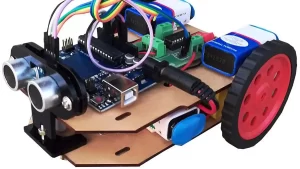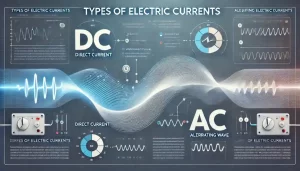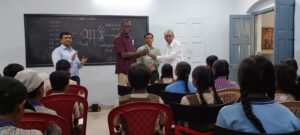With this system we can detect the Arduino based Fastest Figure First Controlling System for Quiz Competition conducted in schools & colleges. For this project you require following components.
Required Components
- Arduino UNO/Nano – 1
- 5mm Red LEDs – 5
- 10mm Red LEDs – 5
- RC sockets – 5
- RC pins – 5
- 1k, 330ohm resistors
- 12V adapter socket – 1
- 12V DC Adapter – 1
- 9V, 1A transformer – 1
- 1N4007 diodes – 2
- Regulator IC 7805 – 1
- 1000uF capacitor – 2
- Small size zero PCB – 1
- PVC boxes 10” x 12” – 2
- PVC boxes 4” x 4” – 5
- Push-to-on switches – 5
- Connecting wires, etc.
Circuit Diagram of the Project

IMPORTANT NOTE: This code of this project is so designed that there is no need for resetting the fastest finger first result, each time, when the competitors press their buttons. The circuit automatically resets itself after 5 seconds and then gets ready for next round.
Practical Guide Video
Prototype Gallery











Pin Configuration Details of Arduino Nano




Comparison of Arduino Nano with Arduino Uno
The following diagram shows the pin configuration details of Arduino Nano with Arduino Uno. You can use either Arduino Nano or Arduino Uno in this project. Be careful to use the particular microcontroller board. Refer this diagram and change the coding lines accordingly.

The Code
/* This code was developed by Vidyasagar Academy Akola,
* www.vsa.edu.in
* License: You can use it for any purpose as long as you don't
* claim that you are its author and
* you don't alter License terms and
* formulations (lines 1-9 of this file).
* Project: The 5 Channel Quiz Controlling System with auto reset using Arduino nano
* Date of Creation: 17.02.2020
*/
/*
======= Connection details =======
Switches connections:
player1: A0, player2: A1, player3: A2, player4: A3, player5: A4
LED1: pin-D2, LED2: pin-D3, LED3: pin-D4, LED4: pin-D5, LED5: pin-D6
Buzzer: pin-D7
*/
int x=1;
int LED1=2;
int LED2=3;
int LED3=4;
int LED4=5;
int LED5=6;
int buzzer=7;
void setup()
{
pinMode(A0,INPUT); // player1 switch input
pinMode(A1,INPUT); // player2 switch input
pinMode(A2,INPUT); // player3 switch input
pinMode(A3,INPUT); // player4 switch input
pinMode(A4,INPUT); // player5 switch input
pinMode(LED1,OUTPUT);
pinMode(LED2,OUTPUT);
pinMode(LED3,OUTPUT);
pinMode(LED4,OUTPUT);
pinMode(LED5,OUTPUT);
pinMode(buzzer,OUTPUT);
reset();
delay(1000);
reset();
delay(1000);
reset();
delay(1000);
reset();
delay(1000);
}
void loop()
{
int a=digitalRead(A0); // reading pin values for 5 buttons
int b=digitalRead(A1);
int c=digitalRead(A2);
int d=digitalRead(A3);
int e=digitalRead(A4);
if(a==LOW) // if player1 presses button
{
if(x==1) // check if x is 1, if yes then execute the code
{
digitalWrite(buzzer,HIGH); // buzzer alert that a switch is pressed
digitalWrite(LED1,HIGH);
x++;
delay(3000);
digitalWrite(buzzer,LOW);
}
}
if(b==LOW) // if player2 presses button
{
if(x==1) // check if x is 1, if yes then execute the code
{
digitalWrite(buzzer,HIGH); // buzzer alert that a switch is pressed
digitalWrite(LED2,HIGH);
x++;
delay(3000);
digitalWrite(buzzer,LOW);
}
}
if(c==LOW) // if player3 presses button
{
if(x==1) // check if x is 1, if yes then execute the code
{
digitalWrite(buzzer,HIGH); // buzzer alert that a switch is pressed
digitalWrite(LED3,HIGH);
x++;
delay(3000);
digitalWrite(buzzer,LOW);
}
}
if(d==LOW) // if player4 presses button
{
if(x==1) // check if x is 1, if yes then execute the code
{
digitalWrite(buzzer,HIGH); // buzzer alert that a switch is pressed
digitalWrite(LED4,HIGH);
x++;
delay(3000);
digitalWrite(buzzer,LOW);
}
}
if(e==LOW) // if player5 presses button
{
if(x==1) // check if x is 1, if yes then execute the code
{
digitalWrite(buzzer,HIGH); // buzzer alert that a switch is pressed
digitalWrite(LED5,HIGH);
x++;
delay(3000);
digitalWrite(buzzer,LOW);
}
}
if(x==2)
{
delay(6000);
digitalWrite(LED1,LOW);
digitalWrite(LED2,LOW);
digitalWrite(LED3,LOW);
digitalWrite(LED4,LOW);
digitalWrite(LED5,LOW);
delay(4000);
reset();
delay(1000);
reset();
delay(1000);
x=p;
}
}
void reset()
{
for(int i=0;i<4;i++)
{
digitalWrite(LED1,HIGH);
digitalWrite(LED2,HIGH);
digitalWrite(LED3,HIGH);
digitalWrite(LED4,HIGH);
digitalWrite(LED5,HIGH);
digitalWrite(buzzer,HIGH);
delay(100);
digitalWrite(LED1,LOW);
digitalWrite(LED2,LOW);
digitalWrite(LED3,LOW);
digitalWrite(LED4,LOW);
digitalWrite(LED5,LOW);
digitalWrite(buzzer,LOW);
delay(100);
}
}
Learn Basics of Arduino Nano
Arduino Nano is a microcontroller board designed by Arduino.cc. The microcontroller used in the Arduino Nano is Atmega328, the same one as used in Arduino UNO. It has a wide range of applications and is a major microcontroller board because of its small size and flexibility.
Download PDF file to understand complete details of Arduino Nano








I just completed this project. Working very nicely.
Please post the next project.
I like what you guys are up too. Such intelligent work and reporting! Keep up the excellent works guys I’ve incorporated you guys to my blogroll. I think it’ll improve the value of my website 🙂
Very nice project.
Thanks for the elaborated details.
Great project…!
I will try it for sure…!
Thanks
The logic behind the coding of this project is excellent.
Taking a variable and making its value change at the hit of a button is really appreciated.